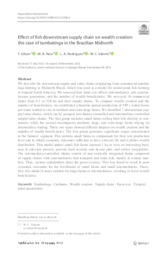Effect of fish downstream supply chain on wealth creation: the case of tambatinga in the Brazilian Midnorth.
Effect of fish downstream supply chain on wealth creation: the case of tambatinga in the Brazilian Midnorth.
Author(s): GILSON, F.; NEW, M. B.; RODRIGUES, L. A.; VALENTI, W. C.
Summary: We describe the downstream supply and value chains originating from commercial tambatinga farming in Midnorth Brazil, which was used as a model for inland pond fish farming in tropical South America. We assessed how farm size affects intermediaries, job creation, income generation, and the number of wealth beneficiaries. We surveyed 16 commercial farms from 0.1 to 220 ha and their supply chains. To compare wealth creation and the number of beneficiaries, we established a baseline annual production of 550 t. Labor hours per tonne tended to rise in medium and extra-large farms. We identified 7 downstream supply/value chains, which can be grouped into farmer-controlled and intermediary-controlled supply/value chains. The first group includes small farms selling their fish directly to consumers, while the second encompasses medium, large, and extra-large farms relying on intermediary trading. These two types showed different impacts on wealth creation and the number of wealth beneficiaries. The first group generates significant wages concentrated in the farmers? segment. This permits small farms to compensate for their low production level and to obtain economic outcomes sufficient to have a decent life and it allows wealth distribution. This model makes small fish farms (around 1 ha or less) an interesting business to alleviate poverty, provide food security and decent jobs, and reduce inequalities. The intermediary-controlled chains consist of non-vertically integrated farms composed of supply chains with intermediaries that transport and trade fish, mostly in remote markets. Thus, various stakeholders share the gross revenue. This was found to result in poor economic outcomes for the livelihoods of small farms and small intermediaries. Therefore, this model is more suitable for large farms or intermediaries, resulting in fewer wealth beneficiaries.
Publication year: 2023
Types of publication: Journal article
Keywords: Piscicultura
Observation
Some of Embrapa's publications are published as ePub files. To read them, use or download one of the following free software options to your computer or mobile device. Android: Google Play Books; IOS: iBooks; Windows and Linux: Calibre.
Access other publications
Access the Agricultural Research Database (BDPA) to consult Embrapa's full library collection and records.
Visit Embrapa Bookstore to purchase books and other publications sold by Embrapa.

